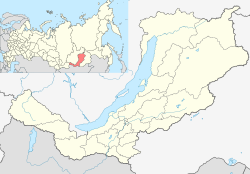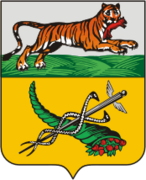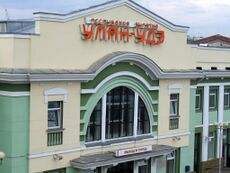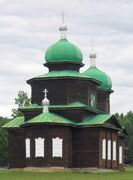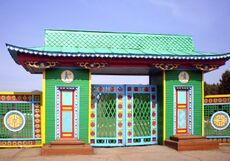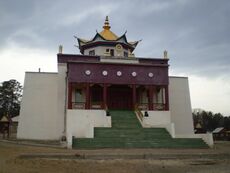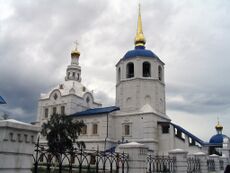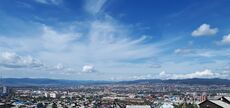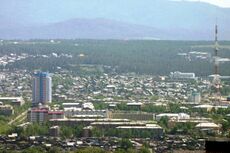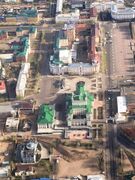أولان أودى
{{ safesubst:#invoke:Unsubst||date=__DATE__|$B=
Ulan-Ude
Улан-Удэ | |
|---|---|
| الترجمة اللفظية بالـ Other | |
| • Buryat | Улаан-Үдэ |
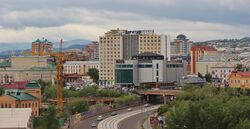 Ulan-Ude City Center | |
| الإحداثيات: 51°50′N 107°36′E / 51.833°N 107.600°E | |
| البلد | روسيا |
| الكيان الاتحادي | Buryatia |
| Founded | 1666 |
| City status since | 1775 |
| الحكومة | |
| • الكيان | City Council of Deputies[1] |
| • Mayor[1] | Igor Shutenkov[1] |
| المساحة | |
| • الإجمالي | 347٫6 كم² (134٫2 ميل²) |
| المنسوب | 500 m (1٬600 ft) |
| التعداد | |
| • الإجمالي | 404٬426 |
| • Estimate (2018) | 434٬869 (+7٫5%) |
| • الترتيب | 45th in 2010 |
| • الكثافة | 1٬200/km2 (3٬000/sq mi) |
| • Subordinated to | city of republic significance of Ulan-Ude[3] |
| • Capital of | Republic of Buryatia |
| • Capital of | city of republic significance of Ulan-Ude[3] |
| • Urban okrug | Ulan-Ude Urban Okrug[4] |
| • Capital of | Ulan-Ude Urban Okrug[4] |
| منطقة التوقيت | UTC+ ([5]) |
| Postal code(s)[6] | 6700xx |
| Dialing code(s) | +7 3012 |
| OKTMO ID | 81701000001 |
| City Day | September's first Saturday |
| الموقع الإلكتروني | ulan-ude-eg |
Ulan-Ude (/ʊˈlɑːnʊˈdɛ/;[7] روسية: Улан-Удэ, النطق الروسي: [ʊˈlan ʊˈdɛ]; Buryat: Улаан-Үдэ, romanized: Ulaan-Üde, IPA: [ʊˌlaːɴ‿ˈʉdə]) is the capital city of Buryatia, Russia, located about 100 كيلومتر (62 mi) southeast of Lake Baikal on the Uda River at its confluence with the Selenga. According to the 2021 Census, 437,565 people lived in Ulan-Ude; up from 404,426 recorded in the 2010 Census,[8] making the city the third-largest in the Russian Far East by population.
Names
Ulan-Ude was first called Udinskoye (Удинское, [ˈudʲɪnskəjə]) for its location on the Uda River. It was founded as a small fort in 1666.[9] From around 1735, the settlement was called Udinsk (Удинск, [ʊˈdʲinsk]) and was granted town status under that name in 1775.[بحاجة لمصدر] It was renamed Verkhneudinsk (Верхнеудинск, [vʲɪrxnʲɪˈudʲɪnsk]; "Upper Udinsk") in 1783, to differentiate it from Nizhneudinsk ("Lower Udinsk") lying on a different Uda River near Irkutsk which was granted town status that year.[بحاجة لمصدر]
The descriptors "upper" and "lower" refer to the positions of the two cities relative to each other, rather than the location of the cities on their respective Uda rivers. Verkhneudinsk lies at the mouth of its river, while Nizhneudinsk is along the middle stretch. The current name was given to the city on 27 July 1934 and means "red Uda" in Buryat, reflecting the ideology of the Communist Party of the Soviet Union.
الجغرافيا
Ulan-Ude lies 5،640 كيلومتر (3،500 mi) east of Moscow and 100 كيلومتر (62 mi) southeast of Lake Baikal. It is 600 متر (2،000 ft) above sea level at the foot of the Khamar-Daban and Ulan-Burgas mountain ranges, next to the confluence of the Selenga River and its tributary, the Uda, which divides the city.[10]
Hydrography
Ulan-Ude is traversed by two rivers, the Selenga and Uda. The Selenga provides the greatest inflow to Baikal Lake, supplying 50% of all rivers in its basin. The Selenga brings about 30 متركيلو مكعب (7 cubic mile) of water into the lake per year, exerting a major influence on the lakewater's renewal and its sanitary condition. Selenga is the habitat of the most valuable fish species such as Omul, Siberian sturgeon, Siberian taimen, Thymallus and Coregonus.[بحاجة لمصدر]
Uda is the right inflow of the Selenga river. The length of the watercourse is 467 كيلومتر (290 ميل).
Military depot
The largest known Russian military equipment storage base is located in Vagzhanovo, northwest of Ulan-Ude. Prior to the invasion of Ukraine in 2022, approximately 3840 units of armored vehicles were stored there under open skies. Since the advent of the war, more than 40% of the units have been removed.[11]
التاريخ
The first occupants of the area where Ulan-Ude now stands were the Evenks and, later, the Buryat Mongols. Ulan-Ude was settled in 1666 by the Russian Cossacks as the fortress of Udinskoye. Due to its favorable geographical position, it grew rapidly and became a large trade center which connected Russia with China and Mongolia and, from 1690, was the administrative center of the Transbaikal region.[بحاجة لمصدر]
By 1775, it was known as Udinsk, and in 1783 it was granted city status and renamed Verkhneudinsk. After a large fire in 1878, the city was almost completely rebuilt. The Trans-Siberian Railway reached the city in 1900 causing an explosion in growth. The population, which was 3,500 in 1880, reached 126,000 in 1939.[12]
From 6 April to October 1920, Verkhneudinsk was the capital of the Far Eastern Republic (Дальневосточная Республика), also known as the Chita Republic.[13] It was a nominally independent state that existed from April 1920 to November 1922 in the easternmost part of the Russian Far East. On 27 July 1934, the city was renamed Ulan-Ude.[بحاجة لمصدر]
Administrative and municipal status
Ulan-Ude is the capital of the republic.[14] Within the framework of administrative divisions, it is incorporated as the city of republic significance of Ulan-Ude — an administrative unit with the status equal to that of the districts.[3] As a municipal division, the city of Ulan-Ude is incorporated as Ulan-Ude Urban Okrug.[4]
السكان
| السنة | تعداد | ±% |
|---|---|---|
| 1897 | 8٬086 | — |
| 1926 | 29٬425 | +263.9% |
| 1939 | 125٬690 | +327.2% |
| 1959 | 175٬172 | +39.4% |
| 1970 | 253٬569 | +44.8% |
| 1979 | 300٬370 | +18.5% |
| 1989 | 352٬530 | +17.4% |
| 2002 | 374٬854 | +6.3% |
| 2010 | 404٬426 | +7.9% |
| 2021 | 437٬565 | +8.2% |
| Source: Census data | ||
According to the 2021 Census, 437,565 people lived in Ulan-Ude;[15] up from 404,426 recorded in the 2010 Census.[2] In terms of population, it is the third-largest city in eastern Siberia. It ranks 45th among all cities in Russia. Roughly 600,000 people live in the urban agglomeration.
The ethnic makeup of Ulan-Ude in 2021 was:[16]
The city is the center of Tibetan Buddhism in Russia and the important Ivolginsky datsan is located 23 km (14 mi) from the city.
Transportation
Ulan-Ude is located on the main line (Trans-Siberian line) of the Trans-Siberian Railway between Irkutsk and Chita at the junction of the Trans-Mongolian line (the Trans-Mongolian Railway) which begins at Ulan Ude and continues south through Mongolia to Beijing in China.
The city also lies on the M55 section of the Baikal Highway (part of the Trans-Siberian Highway), the main federal road to Vladivostok.[بحاجة لمصدر] Air traffic is served by the Ulan-Ude Airport (Baikal), as well as the smaller Ulan-Ude Vostochny Airport. Intracity transport includes tram, bus, and marshrutka (share taxi) lines.[بحاجة لمصدر]
Culture
Until 1991, Ulan-Ude was closed to foreigners. There are old merchants' mansions richly decorated with wood and stone carving in the historical center of Ulan-Ude, along the river banks which are exceptional examples of Russian classicism. The city has a large ethnographic museum which recalls the history of the peoples of the region. There is a large and highly unusual statue of the head of Vladimir Lenin in the central square: the largest in the world. Built in 1970 for the centennial of Lenin's birth and weighing 42 tons, اعتبارا من 2018[تحديث] it continued to tower over the main plaza at 7.7 متر (25 ft).[17]
Sights
The Ethnographic Museum of the peoples of Transbaikal is one of Russia's largest open-air museums. The museum contains historical finds from the era of the Slab Grave Culture and the Xiongnu until the mid 20th century, including a unique collection of samples of wooden architecture of Siberia.
Odigitrievsky Cathedral – Eastern Orthodox Church Diocese of the Buryat, was the first stone building in the city and is a Siberian baroque architectural monument. The cathedral is considered unique because it is built in a zone of high seismic activity in the heart of the city on the banks of the River Uda River where it flows into the Selenga.
One of the attractions of Ulan-Ude is a monument in the town square — the square of the Soviets — in the form of the head of Lenin (sculptors G.V. Neroda, J.G. Neroda, architects Dushkin, P.G. Zilberman). The monument, weighing 42 tons and with a height of 7.7 متر (25 ft), was opened in 1971 in honor of the centenary of Lenin's birth.[17]
المناخ
Ulan-Ude can be described as possessing a humid steppe climate (Köppen climate classification BSk), bordering on a humid continental climate (Dwb) and a subarctic climate (Dwc). The climate is characterised by long, dry, cold winters and short but very warm summers. Precipitation is low and heavily concentrated in the warmer months.
The record high is 40.6 °C (105.1 °F) on 8 July 2016. The record low is −54.4 °C (−65.9 °F) on 6 January 1931. Temperatures have never risen above freezing from 31 December to 1 February, inclusive.
Economy
The Ulan-Ude Aviation Plant is based in Ulan-Ude.
Mongol Rally
Ulan-Ude serves as the endpoint for the Mongol Rally.
Notable people
- Dmitry Masleev, pianist
- Oksana Omelianchik, artistic gymnast
- Irina Pantaeva, Sports Illustrated model
- Alexander Slastin, actor
- Inna Stepanova, Olympic archer
- Gunsyn Tsydenova, politician
Gallery
Ulan-Ude railway station on the Trans-Siberian Railway
A Russian Old Believer church moved to the ethnographic museum in Ulan-Ude
Gate of the Ulan-Ude Ethnographic Museum
The largest head of Soviet leader Vladimir Lenin ever built was in Ulan-Ude as of 2018
Panoramic view of Ulan-Ude
Twin towns - sister cities
 Anyang, South Korea
Anyang, South Korea Berkeley, USA[19]
Berkeley, USA[19] Changchun, China
Changchun, China Chita, Russia
Chita, Russia Darkhan, Mongolia
Darkhan, Mongolia Donetsk, Ukraine
Donetsk, Ukraine Elista, Russia
Elista, Russia Erdenet, Mongolia
Erdenet, Mongolia Erenhot, China
Erenhot, China Grozny, Russia
Grozny, Russia Haeju, North Korea
Haeju, North Korea Hohhot, China
Hohhot, China Hulunbuir, China
Hulunbuir, China Lanzhou, China
Lanzhou, China Manzhouli, China
Manzhouli, China Rumoi, Japan
Rumoi, Japan Taipei, Taiwan
Taipei, Taiwan Ulaanbaatar, Mongolia
Ulaanbaatar, Mongolia Ulanqab, China
Ulanqab, China Yalta, Ukraine
Yalta, Ukraine Yamagata, Japan
Yamagata, Japan Yeongwol County, South Korea
Yeongwol County, South Korea
Notes
References
- ^ أ ب ت "Baikal24".
- ^ أ ب Russian Federal State Statistics Service (2011). "Всероссийская перепись населения 2010 года. Том 1". Всероссийская перепись населения 2010 года (2010 All-Russia Population Census) (in Russian). Federal State Statistics Service. Retrieved June 29, 2012.
{{cite web}}: Invalid|ref=harv(help); Unknown parameter|trans_title=ignored (|trans-title=suggested) (help)CS1 maint: unrecognized language (link) - ^ أ ب ت Resolution #431
- ^ أ ب ت Law #985-III
- ^ "Об исчислении времени". Официальный интернет-портал правовой информации (in Russian). 3 June 2011. Retrieved 19 January 2019.
{{cite web}}: CS1 maint: unrecognized language (link) - ^ Почта России. Информационно-вычислительный центр ОАСУ РПО. (Russian Post). Поиск объектов почтовой связи (Postal Objects Search) (in روسية)
- ^ "Ulan-Ude definition and meaning". Collins English Dictionary. Retrieved 10 February 2024.
- ^ Russian Federal State Statistics Service (May 21, 2004). "Численность населения России, субъектов Российской Федерации в составе федеральных округов, районов, городских поселений, сельских населённых пунктов – районных центров и сельских населённых пунктов с населением 3 тысячи и более человек" (XLS). Всероссийская перепись населения 2002 года [All-Russia Population Census of 2002] (in Russian). Retrieved August 9, 2014.
{{cite web}}: Invalid|ref=harv(help); Unknown parameter|trans_title=ignored (|trans-title=suggested) (help)CS1 maint: unrecognized language (link) - ^
 Chisholm, Hugh, ed. (1911). . دائرة المعارف البريطانية. Vol. 27 (eleventh ed.). Cambridge University Press. p. 1023.
Chisholm, Hugh, ed. (1911). . دائرة المعارف البريطانية. Vol. 27 (eleventh ed.). Cambridge University Press. p. 1023. {{cite encyclopedia}}: Cite has empty unknown parameter:|coauthors=(help) - ^ transsibirskaya.com
- ^ "Moscow Times: Over 40% of tanks removed from Russia's largest storage site since Ukraine invasion". Euromaidan Press. 8 August 2023. Retrieved 10 February 2024.
- ^ britannica.com
- ^ Bisher, Jamie (June 2005). White Terror: Cossack Warlords of the Trans-Siberian. Routledge. pp. 302–03. ISBN 9781135765958.
- ^ "Russia's federal constituent entities". Federation Council of the Federal Assembly of the Russian Federation (in الإنجليزية). Retrieved 2021-03-05.
- ^ "Оценка численности постоянного населения по субъектам Российской Федерации". Federal State Statistics Service. Retrieved 1 September 2022.
- ^ "Национальный состав и владение языками". Federal State Statistics Service. Retrieved 17 June 2023.
- ^ أ ب Памятник В. И. Ленину (in الروسية). Monulent.ru. Retrieved 17 April 2018.
- ^ "Города-побратимы". ulan-ude-eg.ru (in الروسية). Ulan-Ude. Archived from the original on 2020-03-01. Retrieved 2020-02-01.
- ^ "Sister Cities - City of Berkeley, CA". www.cityofberkeley.info. Retrieved 2020-09-25.
Sources
- Pages using gadget WikiMiniAtlas
- CS1 errors: unsupported parameter
- Articles with روسية-language sources (ru)
- مقالات المعرفة المحتوية على معلومات من دائرة المعارف البريطانية طبعة 1911
- CS1 uses الروسية-language script (ru)
- CS1 الروسية-language sources (ru)
- Short description is different from Wikidata
- Coordinates on Wikidata
- Pages using infobox settlement with image map1 but not image map
- Articles containing روسية-language text
- Pages using Lang-xx templates
- Articles containing Buryat-language text
- مقالات ذات عبارات بحاجة لمصادر
- Articles with unsourced statements from April 2018
- مقالات فيها عبارات متقادمة منذ 2018
- جميع المقالات التي فيها عبارات متقادمة
- عواصم جمهوريات روسيا
- Ulan-Ude
- Transbaikal Oblast
- Populated places established in 1666
- 17th-century establishments in Russia
- 1666 establishments in Russia
- Russian Far East
- صفحات مع الخرائط




